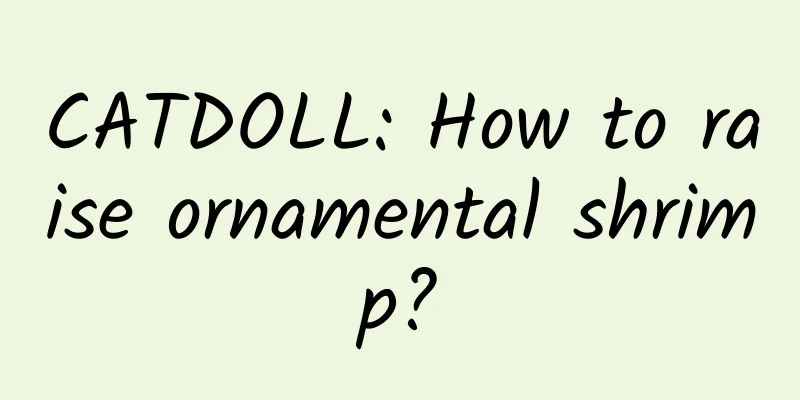CATDOLL : CATDOLL: How to raise ornamental shrimp?

How to raise ornamental shrimp?Ornamental shrimp There are some differences between the breeding of ornamental shrimp and ornamental fish. Ornamental shrimp need shrimp houses or shrimp tubes for hiding, while ornamental fish need some aquatic plants. There are many differences in many aspects. So, what should we pay attention to when breeding ornamental shrimp? How to breed ornamental shrimp? 1. There are two major categories of freshwater ornamental shrimp 1. Small ornamental shrimps are about 3 cm in size, such as cherry shrimp, crystal shrimp, Su shrimp, etc. 2. The logo of the crayfish series is the claws, which are large pincers. The sizes range from 5 cm to 30 cm. There are many kinds, such as mini orange claws, blue devil, and white claws. 2. These two categories of pure white shrimp 1. Among the small shrimps there are platinum shrimps; 2. There are white claws in the crayfish series. Platinum shrimp can only grow to 3 cm, and they can reproduce at this size, but it is somewhat difficult. There is no problem with mixed breeding, and they will not fight. Don't worry about molting. It is fine as long as there is a hidden environment in the tank, mainly with a lot of aquatic plants. The lifespan is about 1 to 1.5 years. Small shrimps do not require much space, and a tank as small as 20 cm will do. The key is to control the water quality. White claws can grow to a maximum of 15 cm, and can reproduce when they are more than 10 cm. It is difficult to raise crayfish together, unless the tank is large and has a lot of space. In addition, each shrimp must have its own shrimp house or shrimp tube for the shrimp to hide in. Mixed breeding will definitely cause fights, and the lifespan can only be more than 2 years. Ornamental shrimp 3. Feeding Methods To raise high-quality ornamental shrimp, the most important thing is water quality. Ornamental shrimps have relatively high requirements for water quality. They are different from ordinary ornamental fish. They are very sensitive to water quality. Generally speaking, the pH value of the water in the tank for raising ornamental shrimps is between 5-8, and the KH value (relative hardness of water) is between 1-6. Moreover, the conditions of pH value 6.2-6.8 and KH value 1-2 are more suitable. [When raising, you still need to adjust the water quality standards of the fish tank according to the different needs of different ornamental shrimps] Ornamental shrimps have high requirements for water temperature and are very sensitive to changes in water temperature. Therefore, when raising them, they also have high requirements for temperature control. Strictly speaking, ornamental shrimps are not suitable for high-temperature breeding. Under normal circumstances, it is more reasonable to control the water temperature between 22-24 degrees Celsius. When the ornamental shrimps are in the breeding period, the water temperature should be reasonably increased by 1-2 degrees. When the water temperature reaches 25 degrees Celsius, it is the best temperature for hatching eggs. To raise ornamental shrimps well, bait is still an important aspect. Shrimp are omnivorous, basically "vegetarian" is the main food, and occasionally they can eat meat. Grain grains, flake grains, bloodworms, brine shrimp, moss, algae, water plants, mud minerals, special food for freshwater shrimps, organic spinach, etc. can all be food for ornamental shrimps. Among them, spinach may be a more popular food for shrimps. In the process of feeding ornamental shrimps, it is necessary to ensure that their food is nutritious and balanced. It is necessary to reasonably match the food to feed the ornamental shrimps. Long-term single diet is also not good for the health of shrimps. Ornamental shrimps are relatively fragile. It is best not to touch them with bare hands during the breeding process, because there are a lot of bacteria on your hands, which may make the ornamental shrimps sick. Another thing to note is that all ornamental shrimps will be attacked by other shrimps when molting, so they should be isolated. The key is to see what kind of ornamental shrimp you raise. There are rice shrimps and crayfish. Different shrimps have painless ways of raising them. For crayfish, basically use black sand as the bottom sand, add volcanic rocks and coral bones, turn on the filter, and make a nest for them. The temperature should be 24-25, and the pH should be weakly alkaline. Feed them small river shrimps, red worms, small fish, water plants, carrots, and corn. There are many categories of rice and shrimp Cherry, black shell, golden rice shrimp, golden back shrimp, it is best not to raise them together, the next generation will be mixed, the shell will be black, not good looking, this part of the neutral water or slightly acidic water is suitable, must be water fairy, generally use mud as the bottom sand, the temperature is also 24-25, feed feed Sulawesi shrimp This is very difficult to raise. Use shell sand as the bottom sand, add coral bones and volcanic rocks, water spirits, filtration, weak alkalinity, and the conductivity is about 400. The key is the algae. They generally eat green algae and are not very averse to artificial feed. Crystal shrimp: temperature 25, 6 readings, weak acid, I have never raised this, so it is hard to say There are also Yamato algae shrimp and tennis shrimp, which are basically the same as raising cherry blossoms. The water should not be too deep, it must be filtered, do not feed too much, use special sand and buy a house for it. A rapid method of cultivating ornamental shrimps in water How to raise ornamental shrimps without dying? What are the breeding techniques?If you want to keep ornamental shrimp alive, you must first pay attention to the water quality. The pH of the water body should be maintained at around 5-8, and the hardness should be controlled between 1-6. Secondly, pay attention to the water temperature, which should be maintained at 22-24℃. It can rise by 1-2℃ during the breeding period, but it cannot exceed 28℃. Pay attention to feeding feed at ordinary times, usually spinach, and feed it twice a week. During the molting period of shrimp, it must be fully oxygenated to ensure its safe molting. 1. Pay attention to water quality When raising ornamental shrimp, you must pay attention to the water quality. It has high requirements for water bodies. If the ammonia nitrogen in the water is high, it will affect its survival. Usually the pH of the water body should be maintained between 5-8, and the hardness should be maintained at around 1-6. If you find that the shrimp are floating more, it means that the water quality is not good enough and a lot of water needs to be changed. In addition, if the color of the shrimp body becomes lighter, it also means that the water quality has deteriorated. 2. Control the water temperature Ornamental shrimps are sensitive to water temperature, usually the temperature should be kept at around 22-24℃, as long as it can be raised by 1-2℃ during the breeding period, the water temperature can be maintained at 25℃. It should be noted that the higher the water temperature, the lower the dissolved oxygen content in the water body, and this animal itself has a higher demand for oxygen, so it is necessary to pay attention to temperature control, usually the temperature should not exceed 28℃, otherwise it will cause the female shrimp to be unable to carry eggs. 3. Feeding Although ornamental shrimps are omnivores, they prefer vegetarian food. Spinach is often used as feed, and can be fed once or twice a week. First, soak fresh spinach in clean water with salt for about ten minutes, then wash it three times, and then boil it in water for 3-5 minutes until the leaves can be broken by hail. After taking out the spinach, rinse it with cold water, and then cut it into pieces for feeding. 4. Shelling method: When the ornamental shrimp grows to a certain size, it will shed its shell. Shelling is very dangerous. If it fails, it will die. In order to increase the success rate of shelling, you should pay attention to supplement some nutrition. You can put a few vitamin B12 tablets. At the same time, when shelling, you should also oxygenate the water. |
<<: CATDOLL: How to feed parrot fish to make the fish's color more red?
Recommend
CATDOLL: How to raise summer silkworms
For silkworms raised in summer, mulberry leaves n...
CATDOLL: What are the nutritional values of yellow bone, olive fillet and turbot?
What are the nutritional values of yellow bone,...
CATDOLL: There is a kind of insect, brown and black, similar to a cockroach but without antennae. It is smaller than a cockroach, has an oval body and a very hard shell.
There is a kind of insect, brown and black, simil...
CATDOLL: Survey on product quality and market reputation of Shenyang Yangxiang Feed Company
How is Shenyang Yangxiang Feed? Feed is an indisp...
CATDOLL: I have 7 fish in a 1m fish tank. I use a submersible pump. I just added an air pump and it has been a week but it has not worked at all. I used to use a 3-in-1 pump for the 80m tank.
1. I have 7 fish in a 1m fish tank. I use a subme...
CATDOLL: How long does it take to harvest golden cicadas? (How long does it take to harvest golden cicadas?)
1. How many years does it take for cicada monkey ...
CATDOLL: How to deal with newly bought bloodworms (How to deal with newly bought bloodworms before feeding them to fish)
1. What to do with leftover frozen red worms? If ...
CATDOLL: Is pomfret a deep-sea fish? Can it be farmed?
There are many varieties of pomfret, some of whic...
CATDOLL: How many days can the red worm live after you buy it? (How many days can the red worm live after you buy it?)
1. I need help from my friends. How do I store re...
CATDOLL: Firefly Feeding (Firefly Feeding)
1. What are the detailed methods for feeding fire...
CATDOLL: What are the techniques for breeding stone frogs?
1. What are the techniques for breeding stone fro...
Why does the cat feel bad after taking the cat triple shot?
Some cats will have mild vaccine allergic reactio...
CATDOLL: There is a nest of bees in a tree hole with only one entrance. How can I catch them out?
There is a nest of bees in a tree hole and there ...
CATDOLL: What is the price of soft-shelled turtle fry and how to release them?
1. What is the price of soft-shelled turtle fry a...
CATDOLL: The flower language of the water demon banana is "natural beauty"
How can the flower language of a flower called &q...









